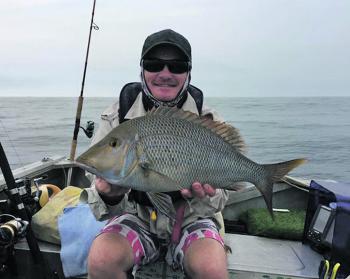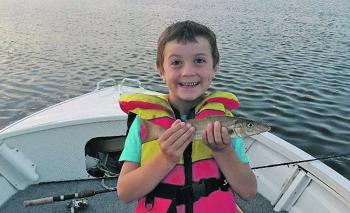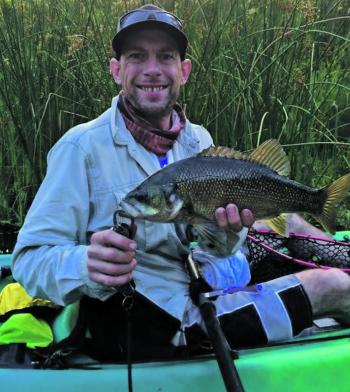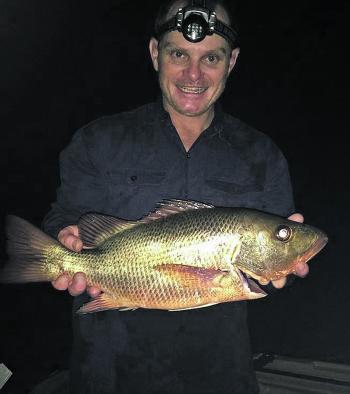With strong northerly winds blowing, last month saw a mixed result for fishing in the region. Colder ocean temperatures mean snapper and other winter species hang around longer on the close reefs. Unfortunately, it keeps all the pelagic species away. Northerlies mean warmer water temperatures in the rivers, so jacks, GTs, whiting and flathead are on the chew.
With the water temperatures sitting around the 22-23°C mark, colder water species should hang around longer on the close reefs. Quality table fish including snapper, pearlies, spangled emperor, golden snapper and tuskies are still regularly caught. Light weighted plastics, un-weighted strip baits and pilchards are doing all the damage on these species. Try Fidos, 5 Mile, 9 Mile, 24 and 36 fathom reefs with good soundings of fish.
There have been reports of small packs of mahimahi around the FAD and on the 50s. Try trolling skirts and flicking metals for the best result on these speedsters. Big kings and GTs are still hanging around the 9 Mile, with live bait doing all the damage on these knucklers. They’re the talk of the town this month, so get onto it before the crowds do.
Estuary water temperatures are sitting at 26-28°C, which is perfect for the summer pelagic species. Mangrove jack really love warm water and northerlies and are obliterating tackle. Try deep diving lures and live baits along Chinderah rock walls, Cobaki Bridge, Boyds and Tumbulgum Bridge. Jacks have also been caught around the Condong Sugar Mill. Watch your baits up there, as there are bull sharks in the water.
Warm waters make these big girls push up the system to drop their pups off, so stay safe. Whiting and flathead are firing. Poppers, yabbies and worms still produce quality fish. Try drifting sand banks on the high tide and drifting off drop offs on the run out tide. Bigger flathead like the 3” and 4” plastics.
The Piggery, Terranora, Cobaki, and Stotts Island sand banks are fishing well. GTs and bigeye are around Boyds Bay Bridge and Jack Evans Anchorage. Blades, small micro-jigs and live baits are your best bet for these speedy brutes.
Good numbers of mud crabs move around on the big tides and full moon. A well-placed pot in a back creek, drain or hole is your best bet for a big can opener. Remember regulations, size and bag limits.
Gutters on the open beaches from Fingal to Byron Bay have quality dart, whiting, flathead and bream. Find a well draining gutter on the run out. These species hang in the waves and drains waiting to pick up your bait and any food that flows past them. Small metals and plastics work well and are a lot of fun on light gear and are dynamite on these wave warriors.
There are heaps of beach worms and pipis on the beaches at the moment so try digging or catching some yourself. It’s a great activity for the kids. The odd tailor and mulloway are still around. Headlands and rock walls still produce fish this month. Try heavy weighted plastics, big baits and whole worms along and around the rocks.
The bass are firing with the cicadas around and high water temperatures in the rivers and dams. The temperature in the rivers is sitting around 27-30°C and the surface temperature of the dam is 28°C. With no real rain around, Clarrie Hall Dam is a bit weeded up, but the river from the spillway right up to the weir wall is fishing well with the Uki stretch producing fat bass.
Early morning and late afternoon are still the peak bite times and winged cicadas are the lure of choice for these feisty fish. Deep diving hardbodies and jig spins working well once the sun is up. Casting for the structure and shaded areas in the deeper pools is a must when fishing for these hard-hitting freshwater brutes. A good fluorocarbon leader is a must.
Summer species should start showing up in numbers, providing the southerlies hang around. Look for warmer current lines to pick up mahimahi, wahoo, blue and black marlin. The 24, 36 and 50 fathom lines should all start producing fish. Warmer waters on close reefs will see mackerel species show up. Try metals, half pillies and troll baits around the 9 Mile, 5 Mile, Fidos and Kingy reefs. They should all produce fish in the coming months.
Jacks will turn on more as the waters warm up. Live bait, deep diving hardbodies, surface lures and plastics are still your best bets. Large strip baits seem to work better on these red dogs as the months go on. Whiting will thicken up and targeting them on a popper or walk-the-dog lure is really fun, especially went you have about four or five of them chasing your lure. Cobaki Lakes, Terranora Lakes, the Piggery and Broadwater are always worth a pop for these ghosts of the flats.
| Crabs will be on the move next month. They move on the high tides around the full moons. Try around freshwater drains and lake overflows for the best results. Rain should see Clarrie Hall Dam open up for the bass | to feed properly. The river will fish well in the next month. Cicadas, hardbodies and jig spins are the lures of choice for most anglers. |
|---|

Kim James with a nice kingfish caught at the 9 Mile Reef on a live bait.

The author with a nice spangled emperor at Fidos caught on a plastic.

Dan Le Mura with a nice GT caught at the 9 Mile Reef using a live bait.

Nixon Stayt with a nice whiting caught on yabbies up Cobaki.

Mark James with over 60cm of jack caught on a live bait at Boyds Bay Bridge.

Malcolm Scott with a healthy bass caught off the surface on a cicada at Uki.

The author with a nice 56cm jack caught on live bait around Cobaki Bridge.




